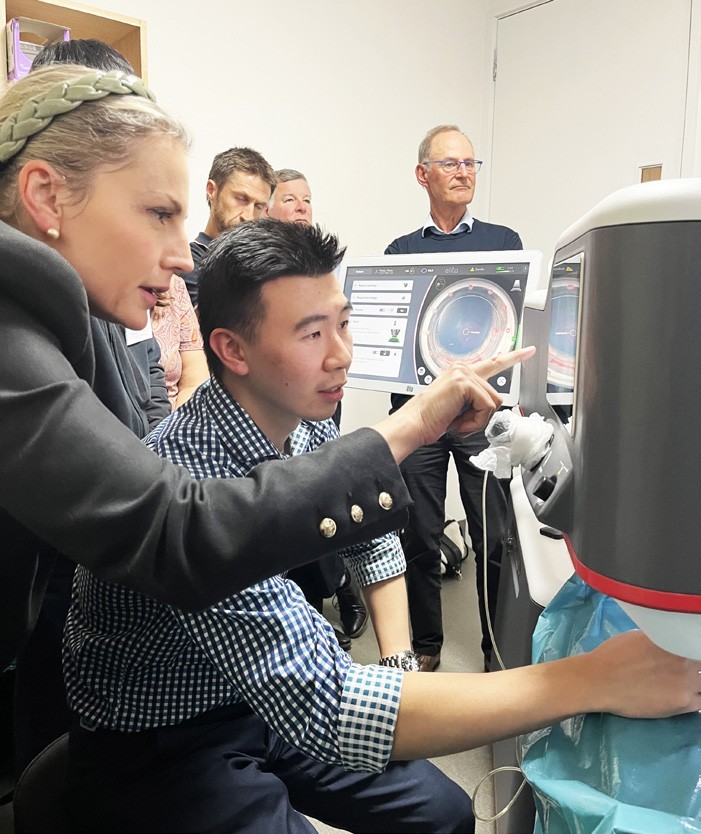minews
First Australian Ophthalmology Clinic Acquires Elita Laser
In an Australian first, NewVision Clinics in Melbourne has invested in Johnson and Johnson's next generation Elita femtosecond laser, which is used to perform the SILK (small incision lenticule keratomileusis) procedure – a lenticular surgery to treat myopia and compound myopic astigmatism by removing a thin lenticule of stromal tissue from the cornea.
According to Johnson and Johnson, the Elita femtosecond laser flap innovation delivers low energy per pulse, combined with an ultra-fast laser repetition rate and small spot size (one µm).1,2,3
This results in a smooth stromal bed, allowing for effortless flap lifts,1,3 which for patients means reduced complications, improved visual outcomes, and fast visual recovery.3,5
NewVision Clinics recently introduced the Elita and SILK procedure to optometrists, at a presentation evening and wet lab hosted at its Cheltenham rooms.
Professor Noel Alpins AM, founder of NewVision Clinics and an internationally renowned cataract and refractive surgeon, described the SILK procedure as “a keyhole procedure, which is like one step forward in laser refractive surgery over and above what we already do with PRK (photorefractive keratectomy) and LASIK (laser assisted in situ keratomileusis). This is an additional procedure, which is now part of our armamentarium that is available to our patients”.
Dr Lana del Porto, a cataract and refractive surgeon who practises with Prof Alpins, said she and her colleagues were “super excited to have bought the Elita femtosecond laser for lenticular surgery”.
Welcoming 24 optometrists to the evening, Dr del Porto described the Elita as “the next generation in corneal refractive technology… a blend of advanced technologies delivering exceptional precision and accuracy in corneal tissue resection”.
“With the Elita, we have the lowest pulse energy per pulse, the smallest spot size, and also (at a total of 16 seconds per procedure) a shorter duration. The small, incredibly even spot size means there’s less collateral damage to the underlying corneal nerve… which enables nerve regeneration to happen more rapidly and with fewer complications, such as dry eye,” she explained.
She described the Elita laser’s contiguous spot placement as “appealing” because “each (laser) spot is touching the spot next door. So there’s less dissection required and it’s a very smooth dissection to remove the lenticule”.
Additionally, she said the SILK procedure uniquely creates a biconvex lenticular shape, enabling the anterior and posterior corneal surfaces to meet together, which minimises corneal folds in the stromal layer, ensuring the optical zone is not compromised.

Dr del Porto said the results being achieved with the Elita at NewVision Clinics have been outstanding.
“One SILK patient – a dentist and a pilot who was a low-to-moderate myope 1.5 with 1D of cyl, told me she was ‘brilliantly happy’ when I saw her at her one-week post-op check. She is now plano in both eyes and glasses free. And the LASIK cases we’ve done so far are amazing… it really is the next generation in femtosecond laser surgery – it’s just so much better than anything I have used before.”
GETTING HANDS ON
Optometrists attending the presentation and wet lab heard about patient selection and work-up prior to the SILK procedure, and were given the opportunity to use the Elita to laser a pig’s eyes, then remove the lenticule.
Having watched the procedure many times online, Davud Ahmed Akgun from Specsavers Broadmeadows, said he was surprised by how different it was to perform in real life (this despite impressing the surgeons with his first-time prowess).
He said the opportunity to experience lasering the pig’s eye would be “absolutely” useful when explaining the procedure to patients “because you kind of know what the ophthalmologist is going to do, exactly what’s going on… and you can reassure the patient about how quick the procedure is”.
References
1. Sachdev, M. ASCRS 2022 LASIK Flap accuracy comparison between a new femtosecond laser and iFS.
2. DOF2023OTH4002: The Elita femtosecond platform patient interface design.
3. DOF2023RF4002: The Elita femtosecond laser device description.
4. 0155-1910 Elita operator's manual (Flap) US edition (v0.2) REF2023RF4014.
5. Sarayba, M. A., Ignacio, T.S., Binder, P.S., Tran, D.B. Comparative study of stromal bed quality by using mechanical, intralase femtosecond laser 15and 30-khz microkeratomes. Cornea. 2007; 26(4):446–451.